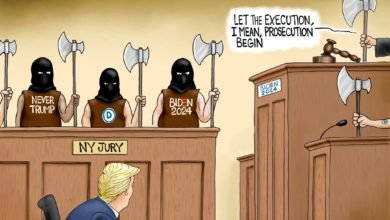Consumer price inflation just hit the highest level in 30 years. Prices rose 6.2 percent from October 2020 to October 2021, according to new government data, prompting a new reckoning with “temporary” inflation that’s proving not so short-lived after all. I interviewed Senator Rand Paul, a libertarian-leaning Republican from Kentucky, to get his perspective on what’s driving our mounting inflation woes.
“I think inflation is pretty easy to explain and people need to know what causes inflation,” the senator said. “[The federal government] gets debt, then the Federal Reserve prints up new money to pay for the debt, that new money enters circulation, and that expansion of the money supply [leads to] inflation.”
Paul argued that this kind of inflation, rooted in government policies, is a “bait-and-switch” form of taxation.
“Big government politicians offer you things they say are ‘free’: free childcare, free healthcare, free college, free cell phones, free this, free that—but it’s not really free,” he said. “Either someone else is going to pay for it through higher taxes, or they’re going to pay for it through borrowing and ultimately inflation. And it really is a bait and switch because often the same people that are being offered free stuff are also the ones who suffer most through the regressive tax that is inflation.”
“We have to explain to people the second order of thinking that goes to understanding that it’s not free,” he concluded.
But what, specifically, is driving the current inflation surge?
“Really the inflation we have this year is probably a responsibility of both parties,” Paul said, referencing the trillions in deficit-financed spending Congress has passed since the COVID-19 pandemic began. “You know, both parties other than myself and a few others were for all the spending of last year. So we borrowed $3-4 trillion last year, and we’re set to borrow at least that much or more this year.”
“I think you may see inflation of 10% or 12% next year,” the senator cautioned. “Now they’re all saying the opposite. The Federal Reserve is saying it’s transitory, but I think the 6% that we’ve got now is based on last year’s borrowing. And I think there’s going to be significantly more borrowing this year. We’ve already spent an extra $2 trillion on a COVID bailout bill, which really didn’t have much to do with COVID, but it was more just a bailout bill, [and now] another trillion on infrastructure.”
But it’s not just Congress, the senator explained, as the Federal Reserve itself shares a large portion of the blame.
“There’s joint blame: Congress is initially to blame for spending money it doesn’t have and then the Federal Reserve says, oh, it’s just our job to paper over this,” Paul said. “It’s our job to buy up that debt and as they do, they create the increased money supply. So really both Congress and the Fed are to blame and they go hand in hand.”
“If we ran a balanced budget, we wouldn’t necessarily need a Federal Reserve,” he continued. “Basically we have a Federal Reserve to pay for all that debt.”
Paul warned that if inflation continues unchecked, we could see a “loss of confidence” in US currency and “people fleeing the dollar.” The senator stressed that with the advent of cryptocurrency, people have more alternatives—taking away protection the dollar may have enjoyed in the past.
I asked Senator Paul about President Biden’s argument that in order to combat inflation, the federal government actually needs to spend trillions more on his “Build Back Better” climate change and welfare agenda.
“President Biden has no idea what causes inflation,” he responded. “I mean, someone should ask him that question. How does [the government] spending more money reduce inflation? How does borrowing more money reduce inflation? That’s some mental gymnastics. It’s hard for me to comprehend.”
I offered the president’s counterargument, bolstered by liberal-leaning economists, that his bill would hugely increase productivity and thus lower inflation pressures over time.
“I think productivity comes from ingenuity and market efficiencies, but I don’t think in any way, productivity is increased by government spending,” Paul countered. “In fact, you could probably argue the opposite.”
“If you had a million dollars and you wanted to let your representatives decide how to spend it, or a bunch of venture capitalists who look at profit and loss and look at markets and make estimates, neither are perfect,” he continued. “It’s all our guesses about the future. But my thinking is that when it comes to the government, it’s politicized. Whereas the investors will only look at profit and loss because their job is narrowly focused towards trying to invest in things that make money.”
“The marketplace is always wiser and smarter than the government,” Paul concluded. “[Remember] what Milton Friedman used to say… that nobody spends somebody else’s money as wisely as their own. And that truism will always mean that the government lacks efficiency and lacks really the drive to make the best decisions for investing. So I would say productivity and the productivity of capital… always has to be less with the government.”
So, the senator warned that if President Biden’s multi-trillion-dollar spending agenda was passed by Congress, it would only worsen, not help, our inflation problems. But Paul noted that this may not happen, because even some moderate Democrats like Senator Joe Manchin are acknowledging the reality of inflation and putting the president’s ambitions on pause.
Only time will tell. But if the federal government fails to rein in its reckless fiscal and monetary policies, we may well see inflation get even more out of control. And nobody will be able to say they weren’t warned.
Content syndicated from Fee.org (FEE) under Creative Commons license.




